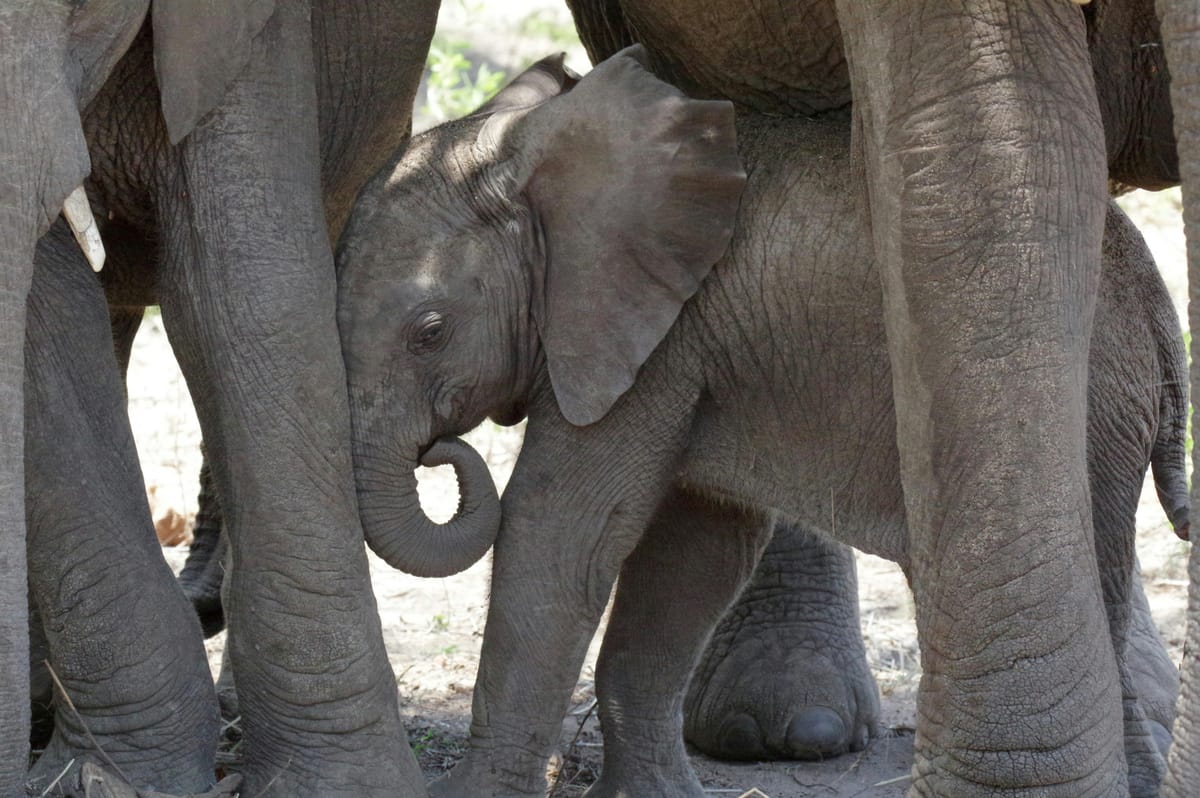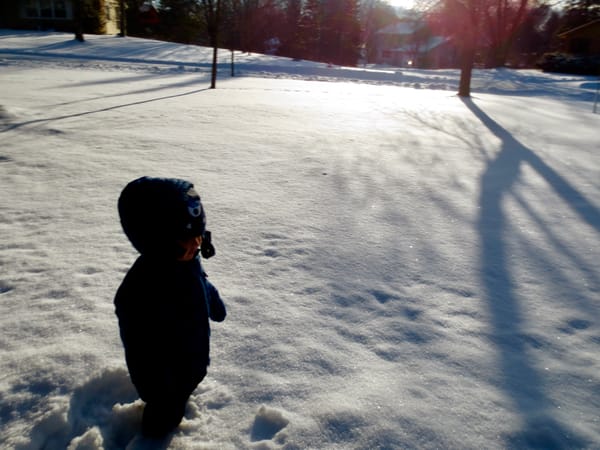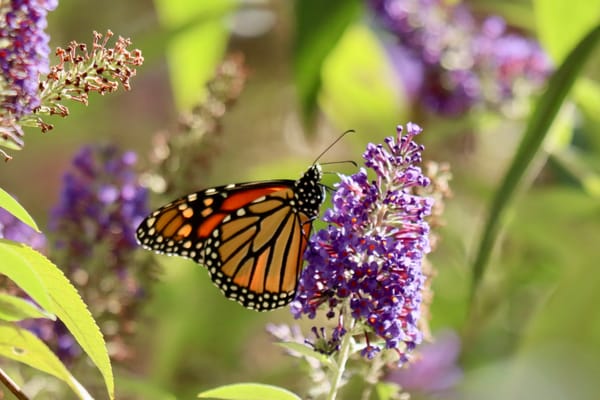The Friendships That Save Us
The math of our friendships isn't what matters most

“But these are the ones
who save us:
not the charmers,
not the comets of wild passion,
not the ups-and-downs of love’s unlucky hungers,
but the ones who stand
by our shoulder at the funeral,
and lead us back to the city of the living
and put our favorite record on the player
and go away, and come back,
always come back,
with bread and wine
and one word, one word: stay.”
~Joseph Fasano
Two weeks ago, a video circulated in the news of a group of elephants at the San Diego Zoo, who formed an alert circle during an earthquake. Forming an alert circle is a natural behavior in the wild, where adult elephants will gather in a tight circle when they sense a threat. They face outward and surround the most vulnerable members of the herd, usually the youngest calves. Watching the video, I was particularly struck by the interaction between one adult elephant and a juvenile elephant next to her. The juvenile elephant was just barely old enough to be part of the outer circle, and even though he took up a position of protection, the elephant next to him repeatedly touched him with her trunk, seeming to check on and reassure him.
We are often fascinated when animals exhibit behaviors that feel very similar to our own human reactions, and elephants, who are both highly intelligent and profoundly social, provide some especially compelling examples of communal care, which resonate strongly with our own instincts. I suspect that we may be even more drawn to stories like this in the present moment, as we humans are facing significant loneliness and complex fractures to communal life, as well as an array of political threats to our security, all of which is surely leaving us raw and fragile and easily captivated by expressions of care.
It is tempting, particularly when we are lonely and afraid, to look for simple causes and easy solutions, and to focus on the things that feel most in our control. Intimate relationships are an easy site for both blame and comfort, because the people in our day-to-day lives are within reach, while so many problems feel too big to hold or solve, and because we are all hungry for the kind of close connection and protection that we saw on display in a circle of elephants.
This past week, the creator of Facebook—perhaps, the original friend tallying system, which taught us to view our relationships by a numerical metric—suggested that the number of friends the average American has is indicative of the broader issues of loneliness we face. He went on to explain that interactions with artificial intelligence might provide a large-scale solution. There’s a lot to question here about the role of technology in our relationships and our general wellbeing, and that is where most of the response to his comments has been focused. However, there has been minimal attention on the basic assumptions his comments conveyed regarding the nature of friendship, the health of our relationships, and the sources of our loneliness. In fact, I haven’t been able to find a single article that actually tracked down the source of the main statistic he sighted—that Americans have an average of three friends—despite the fact that this data is easily accessible. Nor have I seen much effort to unpack his identification of this data point as a problem, even though there is substantial research available on what we need from our friendships, how many relationships we actually benefit from, and on the root causes of loneliness.
Perhaps it’s the preschool teacher in me, having spent many years in the classroom helping young children navigate the ins and outs of making friends and the complexities of budding relationships, but I think it’s important to understand the true nature of friendship and the state of friendships in our lives, before we jump to identify solutions. While I understand that AI is a hot button topic that grabs our attention and heightens our reactiveness, regardless of which side of the technology debate we might align with, the fact that there was relatively little discussion of the primary assertion that our friendships are in some sort of crisis makes me think we need to take a step back and begin by better understanding friendship itself, rather than focusing on what the solution is or whether technology ought to play a role.

First, let’s begin with the number. Do we really only have three friends, and is that something to be worried about? In an economy dominated by a supply and demand mentality, and particularly coming from someone whose success has been based on a technology that literally tallies our online relationships, often into the thousands, it’s not surprising that the number three would seem worryingly small. To begin, the assertion of three friends is rooted in real data. It’s not an invented number. However, identifying this number as a sign of a deeper problem is reflective of a very narrow and misleading read on the data and on the research about friendship in general, which gives crucial texture to the raw numbers.
In 2023, Pew Research released data on American friendships that indicated that most Americans have three to five close friends. This data also showed that a significant percentage of people (38%) have at least five close friends. At the most basic level, the fact that a significant percentage of people reported having five or more close friends already calls into question whether a dearth of friendships is indicated by the actual data.
However, even considering the somewhat inaccurate reading of the core information, it is also essential, in understanding what this data means, to look carefully at what the research examined. The study specifically investigated friendships that the participants defined as “close.” There are many layers to our social lives, and the number of people we consider friends is typically higher than the number of people we consider “close friends.” But the Pew data focused on close friends intentionally, because, in a separate study of American family life, the importance of close friendships emerged as a primary factor in participants’ sense of overall life fulfillment. The introduction to the data on friendships explains,
“Americans place a lot of importance on friendship. In fact, 61% of U.S. adults say having close friends is extremely or very important for people to live a fulfilling life, according to a recent Pew Research Center survey. This is far higher than the shares who say the same about being married (23%), having children (26%) or having a lot of money (24%).”
This distinction is extremely important, particularly when thinking about friendships through a numerical lens and when considering what if any solution might be necessary to improve the health of our relationships. The critical factor in determining whether our close friendships contribute to our wellbeing has more to do with the quality and authenticity of those relationships and the support they offer in our lives than with the number. And, in fact, having too many intimate relationships can create its own stress and risks, as our ability to balance the many demands on our time and attention with the caregiving involved in our closest relationships can stretch us thin.
The psychologist, Robin Dunbar, who has studied friendship extensively, has found that five is typically the maximum number of close friendships we can maintain, and this number includes our most intimate relationships, such as a romantic partner and close family members. Though he describes many different kinds of relationships in our lives, which extend far beyond this primary circle, when it comes to close friends, five is actually the most we can reliably manage. The other spheres of relationships in our lives do matter. But they are simply not the relationships that the research is referencing when describing “close friends.” So it is neither surprising nor concerning that the average American reported having three to five close friends, because the data is speaking to a very specific subset of our relationships—the subset that carries an outsized weight in protecting our wellbeing.
Additionally, as we often see among adolescent social dynamics, larger friend groups can be less healthy and fulfilling than a small group of committed, truly close friends, because superficial connections and hierarchies typically begin to overtake authenticity and deep care in larger groups. This is likely, at least in part, a result of a misalignment in expectations, in which teens seek the same level of care and connection that we are able to give and receive within our closest circle from a larger group. Having more than a few friends isn’t problematic in and of itself, as long as our expectations for closeness are realistically aligned. The adolescent psychologist, Lisa Damour, says,
“You cannot get a collection of people together who like one another equally once you’re hitting more than two or three people. You can't do this at any age, and you sure as heck can't do it in the seventh grade…The least stressed and thus happiest kids have one or two good friends,”
If you’re unsure of how to parse these nuances, I suggest checking in with a preschooler, because, in my experience in the classroom and as a parent, young children will gladly describe the degrees of intimacy and importance among all the people in their lives. They are just beginning to understand and define their friendships, and as such they are like friendship detectives, deeply invested in understanding how their relationships operate and relate to one another. Young children can readily describe the people who are most important to them—usually their parents, siblings, and perhaps one or two best friends—as well as the people they enjoy playing with but who are not necessarily part of this innermost circle, and the people who comprise their wider circles of relationship in their classroom, school, and neighborhood communities. They understand that all of these relationships are important, but they carry different weight and they impact our day-to-day wellbeing differently.

Children also understand, as they move between different groups of family and friends, that the business of friendship is not a perfect science. As Dunbar explains, it is best not to view any of these numbers as the key to some sort of algorithmic aspiration for our relationship goals, aiming to achieve a data-driven map of our most intimate connections, based on quantity. He says,
“If you try and apply rules consciously, everything in all these natural sequences just falls apart. So it’s best not to overthink. The science side is illuminating and interesting in explaining why we do the things we do. But it’s not always helpful to use it as a guidebook.”
Whether we have achieved some ideal number in our relationships doesn’t appear to be a problem, nor should we even be aiming for as many as fifteen close friends, as Zuckerberg proposed we “have demand for.” Further, as Dunbar cautions, attempting to solve loneliness by applying mathematical equations to our relationships is a detrimental approach in and of itself.
Particularly within both the American maximalist mentality and a social-media-stoked follow-count culture, it’s easy to conclude that more friends would be better. But the data doesn’t bear this out. When it comes to friendships, intimacy matters most—feeling meaningfully connected and supported rather than simply achieving a particular number. There is even research to suggest that one close relationship can be enough to protect us from the most severe risks of social isolation. It is when these elements of our lives fray that we begin to feel loneliness creep in. The greatest concern isn’t in having one, three, five, or fifteen friends. It is whether or not we have at least one friend we feel very close to.
For this reason, if the research on close friendships actually does suggest a problem that warrants our attention, it is not within the majority of responses, but rather in the 8%, noted in the Pew data, who reported having no close friends. This is a small percentage of the population, certainly not the majority, but this percentage has risen in recent decades, and it is where the true risk lies. We would do a great service to those most vulnerable in our communities to look closely at this number and to better understand what leads to true isolation, even though it affects a relatively small segment of the population. We tend to gravitate toward the needs of the majority, but often the most dire needs lie in the margins of data.
Additionally, it is true that there is research to suggest that we are feeling increasingly lonely. At first glance, this seems at odds with all of the research I’ve shared about our friendships, which, for the most part, seem to be doing pretty well. So, if the majority of Americans actually have a healthy number of close friends, why do we feel lonely? I suspect this has more to do with the wider fabric of our community connections and the ways we relate to one another, which have morphed significantly. As important as our closest friendships are, the feeling of being embedded in a wider net of familiarity and care is also important, and this warrants its own focus. I’ve written a bit about this in other places, but it is worth returning to.
For now, though, I want to go back to the elephants, because, when we consider loneliness and the power of our closest relationships, there does seem to be something compelling about watching this intimate group of animals instinctively circle to protect each other. And there is something especially powerful about watching the gestures of intimate connection between individuals in this group. There is a reason people were drawn to this video and to observing these creatures care for each other during a frightening moment. There were only seven elephants in this small, captive herd, but the sense of safety they created is palpable, and it is this same feeling that I think we all seek out in our relationships—a feeling that comes from care not from the right head count.
There is even some research to suggest that, as highly social as elephants are, like us they may also have healthier social dynamics in smaller groups. In the wild, elephant herds can range from as few as eight to as many as one hundred. But aggression appears to increase the larger the group. It seems possible that a smaller group of well-known relationships makes elephants feel calmer and safer than a very large group where they are not as able to know each other well.
Instead of worrying about how to increase our friendship metrics, which the research indicates is not a problem that needs a solution, we would be better advised to attend to the quality of our closest relationships—to take a lesson from the elephants and extend a gentle hand to those in our most intimate circles. And we should also look around for the most vulnerable, the percentage among us who are truly alone, and find ways to bring them into the center of our care.
Wishing you a few close and caring friendships,
Alicia
A few things I found helpful and hopeful this week…
- A research agenda to improve lives for autistic people
- A commander’s case for women, peace, and security
- And a few lessons in resilience and acceptance from dogs! This intrepid dachshund survived for over a year on a largely wild South Australian island. And the world’s largest dog befriended the world’s smallest dog.
If you think someone else in your life might need some hope, please share. It’s always easier to hold onto hope when we’re not doing it alone.





